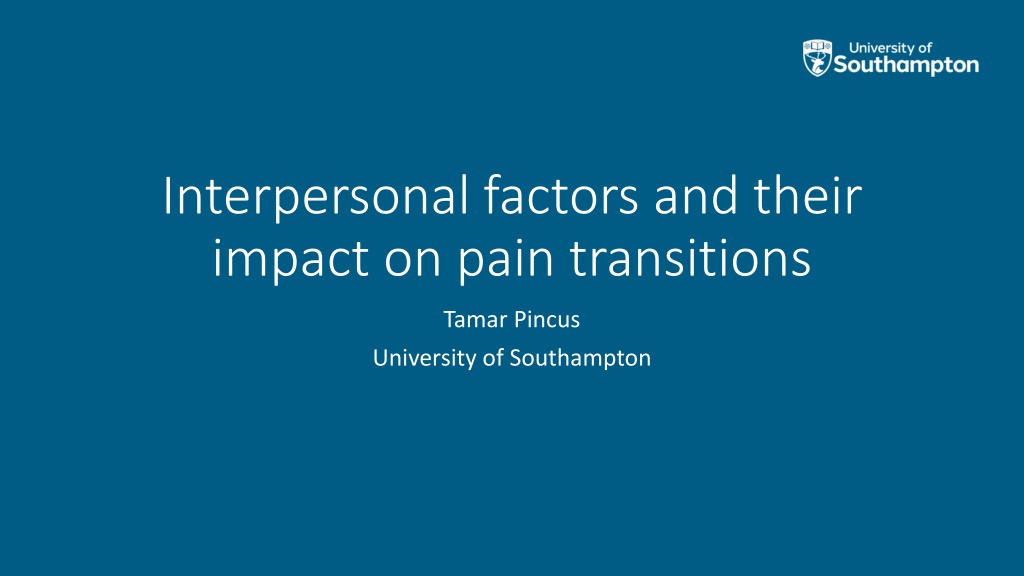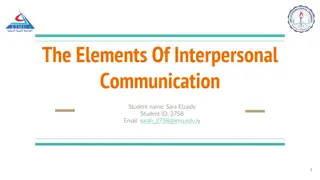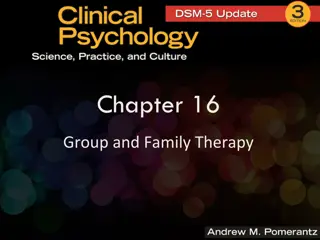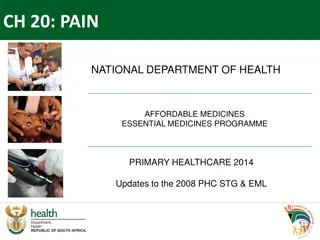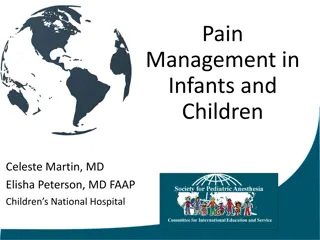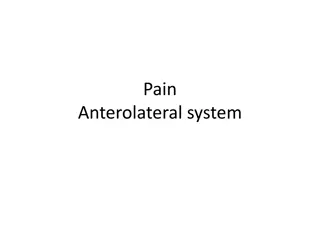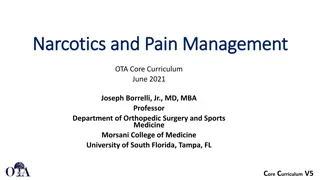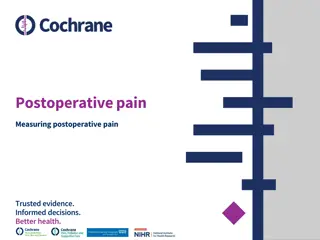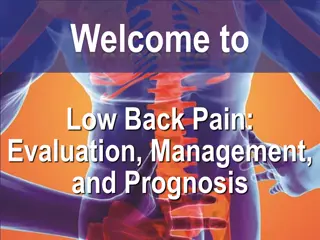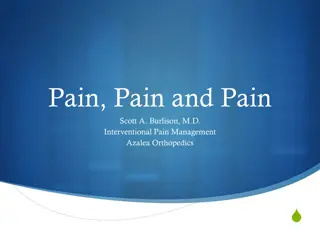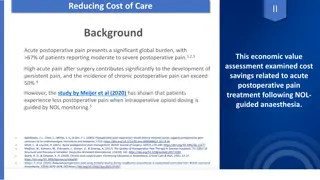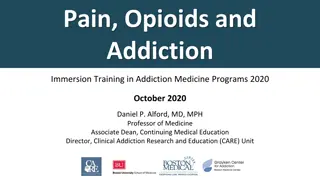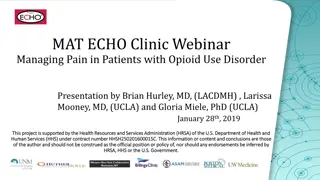Interpersonal factors and their impact on pain transitions
Exploring the impact of interpersonal factors on pain transitions, this research delves into the communication and behaviors between individuals experiencing pain, such as parent-child relationships and interactions with healthcare providers. The study analyzes psychosocial mechanisms influencing pain transitions and highlights key findings on parental catastrophizing and mental health affecting children's pain experiences.
Download Presentation

Please find below an Image/Link to download the presentation.
The content on the website is provided AS IS for your information and personal use only. It may not be sold, licensed, or shared on other websites without obtaining consent from the author. Download presentation by click this link. If you encounter any issues during the download, it is possible that the publisher has removed the file from their server.
E N D
Presentation Transcript
Interpersonal factors and their impact on pain transitions Tamar Pincus University of Southampton
Some definitions Pain transitions The transitions from acute-chronic, chronic-recovery etc. Transitions from / to low / high impact (disability, mood, function ) Interpersonal factors: Communications and behaviours (verbal and non-verbal) Parent / child Partner / person living with pain (PLP) Clinician / PLP (+/- partner)
Psychosocial mechanisms that impact on TRANSITIONS in pain: Persistence, impact Topical Review: The establishment, maintenance, and adaptation of high and low impact chronic pain: a framework for biopsychosocial pain research. Eccleston et al., in Pain, 2023
A series of rapid reviews Empirical studies investigating a familial dyadic interpersonal factor that had a quantitative outcome of pain and a timeline, including prospective cohort studies, experimental studies, and randomised controlled trials. Studies where we were unable to isolate the individual effects of interpersonal factors (e.g., pain management programmes) were excluded. We included people of any age, with any type of pain longer than three months or longer
Family review Family review Prospective cohorts (n = 30) Daily diary studies (n = 7) Studies (n = 43) Experimental (n = 3) RCTs/pilot studies (n = 3) Adult chronic pain unspecified (n = 6) Adult MSK [OA, RA, low back pain] (n = 9) Child chronic pain unspecified (n = 8) Participants* (n = 14, 046) Child abdominal pain (n = 3) Child post-surgical pain (n = 5) *where totals were given Child headache/migraine (n = 4) Parent/child dyads (24 studies; 10,004 participants*) Family members* Partners/patient dyads (18 studies; 3496 participants) Family (1 study; 233 participants) *where totals were stated
Family review Family review key findings key findings Parental catastrophising Parental mental health The effect of parent anxiety, depression or distress on child s pain The effect of parent catastrophising on child s pain 7 studies / 1684 participants 10 studies / 4942 participants Strong evidence that parent catastrophising is associated with worse pain outcomes for child across pain conditions Mixed findings parental anxiety associated with worse child pain outcomes, but no effect of parental depression. One study highlights the importance of diagnostic uncertainty in the formation of parent catastrophising Effect of distress unclear.
Partners Partner support behaviours Operant model: solicitous (expressions of concern, support, and help) thought to reinforce pain behaviours??? The effect of partner support behaviour on persons pain 11 studies / 2045 participants Autonomous, protective, and emotional support associated with better pain outcomes Punishing or reinforcing behaviours associated with increased pain
Conclusions Partners and parents impact on pain perception, pain behaviours and pain experiences (transitions and impact) There is robust evidence that worry, perceived threat, and avoidance play a negative role Research on partners is scarce and theoretically poor.
Can clinicians intervene? It s not what you do, it s the way that you do it
Clinician review Clinician review RCTs [including secondary analyses] (n = 13) Studies (n = 28) Prospective cohorts (n = 12) Experimental (n = 3) Low back pain (n = 11) Osteoarthritis/Rheumatoid arthritis (n = 5) Participants (n = 12852) Other MSK (n = 5) Fibromyalgia (n = 2) Other chronic pain, mainly non-specified (n = 5) GPs (n = 6) Physicians unspecified (n = 9) Clinicians (n = number of studies) Orthopaedic surgeons/surgical teams (n = 3) Physical therapists (n = 3)
Clinician review Clinician review key findings key findings Motivational interviewing Reassurance Validation Empathy 2 studies 4 studies 3 studies 3 studies 551 participants 3370 participants 2486 participants 2446 participants 3 studies with positive effects on pain Significant effects on reducing pain when validated by clinician Small but significant effects for reducing pain across all studies Modest improvements in functioning in participants with chronic pain, but not pain. 1 study had no effect of empathy of pain patients were awaiting joint replacement + beneficial effects on mental health and functioning Potential effects with psychological factors More return to work in MI arm.
Definition from Linton et al., Pain, 2008 reassurance ...removes the fears or doubts of (pain/illness); to comfort Reassurance always takes place within the dynamics of the interaction between the caregiver who has the intention to reduce worry, and the patient who is concerned. Ultimately, reassurance is achieved if the patient changes his/her behaviour, understanding or thoughts. The method of reassurance , on the other hand, is in the behaviour of the healthcare provider (HCP).
What is reassurance made of? Effective Data Gathering Patients perception that you have listened to their whole story Generic reassurance Relationship Building Patients perception that you have validated the story empathically and with integrity Cognitive reassurance Clear and personally relevant explanations about cause, prognosis and options for managements
Our main body of work: mixed methods Primary care Interviews with patients Surgical settings Interviews with patients Adaptation of questionnaire Prospective cohort Interviews with surgical clinicians Intervention development Questionnaire development Prospective cohort
What have patients told us about reassurance? Empathy is important, but to feel reassured, clear explanations are key Being told that there is nothing wrong is not reassuring at all, and leads to a care void
What have clinicians told us about reassurance? Handling patients distress was very challenging, and offering management options limited
Consultation-based Reassurance for LBP Questionnaire Data-gathering Relationship-building Generic reassurance Cognitive reassurance subscale subscale subscale subscale To what extent did the physician ... Encourage you to Show a genuine Tell you that you Explain how the voice your concerns interest in your should not be worried treatment offered regarding your problem would help with your symptoms problem Listen attentively Put you at ease Tell you that Make sure you while you were talking everything would be understood what your fine treatment plan involves Summarise what you Show that he/she Reassure you that Check you understood had told them understood your he/she had no serious the explanation concerns concerns about your he/she gave for your back symptoms
Generic reassurance is associated with worse mood three months on, in patients who were already depressed UK Primary care, n=140 (Holt et al., 2018) Reassurance was associated with perceived global improvement at 2 weeks, and (weakly) with reduced pain and disability at 3 months Patients consulting chiropractors, n=2056 (Simonsen et al., 2021) Reassurance associated weakly with further health care seeking and depression three months after dismissal from orthopaedic consultations without treatment Secondary care, orthopaedic, UK, N= 296, (Braeuninger-Weimer K, et al., 2021)
Conclusion Communication (reassurance, validation, information) from clinicians can change behaviours, mood, cost and disability WHAT WOULD THIS LOOK LIKE?
Primary trigger: Extended pain and disability with diagnostic uncertainty Individual s Heightened pain threat Avoidance of movements and activities Increased disability and distress Partner/Parent heightened worry P / P protective behaviours Reinforcing avoidance P / P P / P trait anxiety validation/ invalidation Effective, reassuring, consultations
Thank you Studies covered in this talk were funded by Versus Arthritis, MRC, Eurospine. We thank all the people, patients and clinicians who helped us.
